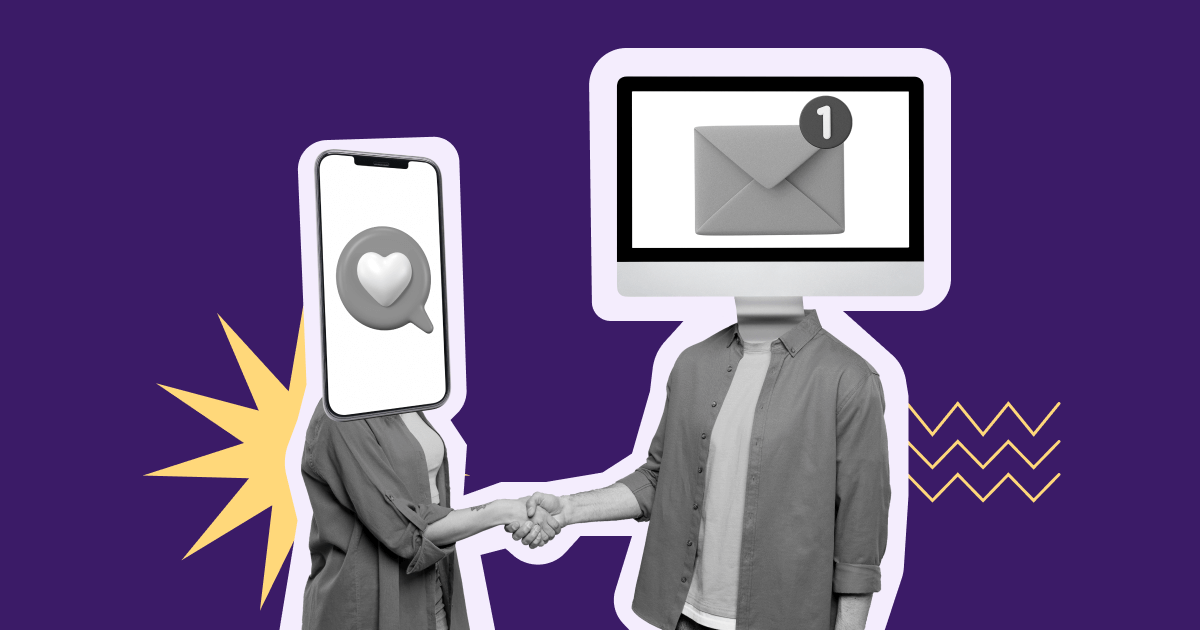Features of social media and email marketing
Social media and email marketing are distinct channels with their own specific functions and benefits. Let’s explore those in detail.
Social media marketing
Social media is a perfect tool to raise brand awareness and recognition. Unlike email marketing, social media marketing extends beyond your existing customer base. You can get noticed and attract new customers. Let’s see what you can do with social media marketing:
- Engage with your audience: you can organize contests, collect reviews, and create discussions. You can also collect customers’ emails via social media and use them in your email campaigns.
- Сommunicate with your audience via visual content to grow engagement. People love spectacular or funny videos and pictures. They feel an emotional link with your brand, share, and comment on your content. Use it to strengthen your connection with the audience.
- Use temporary content formats. YouTube, TikTok, Facebook, and Instagram use a temporary content format called stories. You can attach links to those, for example, a link to your newsletter subscription form. You can produce those photos and videos with your smartphone, it takes no time once you get used to it.
- Collect data and conduct research. Create polls, question forms, etc. It will give you a deeper understanding of your audience. Each answer will also grow engagement.
- Grow brand awareness and reputation. Social media is about the image: customers will start recognizing your brand when they come across it in their feeds from time to time.
- React to feedback quickly. You can receive private messages and answer them in real time. A constant social media presence also creates a strong feeling of reliability: people will know you are always there.
- Promote your products via influencers. Social media is a perfect tool for native advertising. Influencers can show your products in their content and explain what they like about it.
- Show your product. On social media, you can post pictures, videos, feedback from users and experts, etc.
Social media is perfect for brand promotion, creating an emotional connection with your audience, and generating leads.
Email marketing
Email marketing begins with collecting emails. Your clients freely provide their contacts to you, and they confirm that they want to receive your emails. They can also unsubscribe from your newsletter anytime.
That means that you have your most dedicated audience here. Your subscribers most probably are already interested in your product. You can keep them up to date with your news, provide more product details, and drive them closer to conversion.
Here are some tips on how you can use email marketing’s unique features:
- Personalize your messages and grow conversion. For example, you can add your clients’ names or use dynamic content to change product recommendations according to their preferences.
- Segment the audience to make each message relevant to the exact customer group, which also grows conversion. You can ask their gender, age, location, occupation, interests in the subscription form to keep these customer groups separated and craft messages for each of them.
- Automate email sending. You can use email automation to send custom email series and triggered emails that your customer receives automatically after a particular action. For example, if they put something into the cart and didn’t finish the purchase, you can send an abandoned cart email, or send welcome emails right after registration on your website. Automation makes your email marketing strategy run smoothly.
- A/B test your campaigns. Create different versions of the same email to test the effectiveness of an offer, a subject line, etc. Testing can give you insight into what motivates your audience. You can use it for future sendings.
- Analyze your email performance. After each campaign, you can view the open rates, click-through rates, and other metrics, check the deliverability, and then act on your findings.
- Spread your messages from social media. You can put links to your social media posts into your newsletters. That is a win-win: you use the existing content and lead more users to your social media pages.
- Collect feedback. Your subscribers can answer your emails directly to let you know if they need anything. You can also conduct research and create polls via newsletters.
- Reactivate your customers. Keep in touch with those who used to buy your products but for some reason stopped. Ask them if they need any help, give special discounts and gifts, or use other creative ways to reactivate them. After all, you can simply find out why they left — that also is very useful.
- Increase the average bill via cross-sellings. For example, if someone buys a night cream for oily skin, you can send an email with recommendations on oily skin care and a list of products for it: foams, masks, blotting paper, etc.
In general, email marketing is great for sales and retention. Keep in mind that your newsletter subscribers are already interested in your communication. Your task is to cater to their needs driving them closer to conversion and making them repeat sales.




























